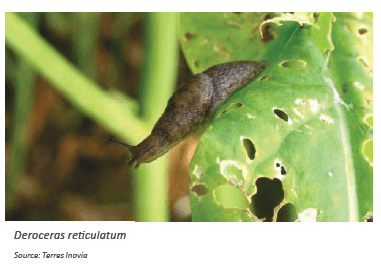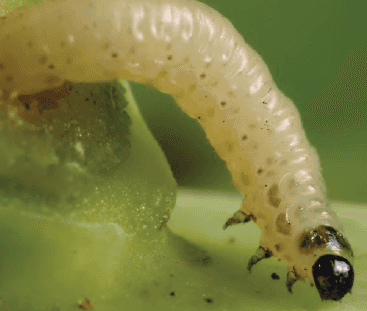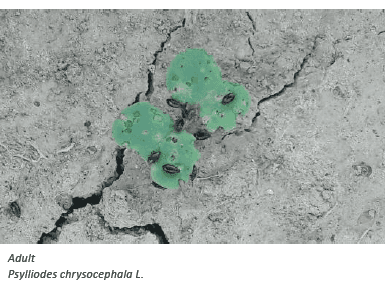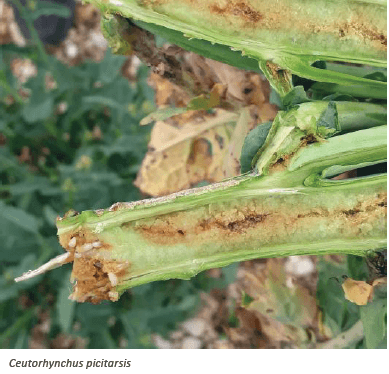MAIN INSECT PESTS IN AUTUMN
Find out about the main pests affecting oilseed rape in autumn. Lidea offers you solutions to avoid damage to your rapeseed crop.


SLUGS

DESCRIPTION
Adult: 35 to 50 mm in length, grey-beige colour. Whitish mucus. Young: 4 to 5 mm in length, pink or wine brown body. Whitish mucus.
DAMAGE
The critical period for seedlings is from the emergence to the 4-true-leaf stage. Slug attacks during this period can kill plants.
SOLUTIONS
• Seedbed preparation before sowing can significantly reduce the number of slugs. Uncultivated soil may contain residues from previous crops which can provide a haven for slugs.
• Examine the field for slug presence before sowing. Leave traps overnight and examine early the following morning when soil is visibly moist.
• The application of a pesticide at sowing time is another effective method to avoid damage. Monitor crops throughout the early susceptible growth stages.
APHIDS

DESCRIPTION
Winged: 1.5 to 2.5 mm in length, slender, green to pale yellow abdomen, black head and thorax. Wingless: 1.5 to 2.5 mm in length, ovoid and naked body, often greenish. Legs, antennae and cornicles are relatively long.
DAMAGE
Rarely reaches levels causing direct feeding damage. Can cause significant yield loss through diseases introduced by viruses. Mosaïc viruses are less frequent but more harmful compared to turnip yellow virus (TuYV). In autumn, symptoms can be observed on leaves, including purple tingeing of leaf blades and pods.
SOLUTION
Regular plant examination from the emergence until 5-6 leaves stage. In case of more than 20% infestation, further action is required. Aphids are resistant to a number of insecticides, so options for chemical control are limited. Insecticide application after the 6-leaves stage is not efficient. For effective aphid control, it is recommended to use varieties with TuYv resistance.
FLEA BETTLES (larvea)

DESCRIPTION
1.5 to 1.8 mm in length, white colour, elongated form. Dark brown head, three pairs of legs and dark plate at the tail end.
DAMAGE
The larvae undermine the petioles during autumn and winter. Attacks are highly detrimental to stunted plants, with late recovery, because larvae feed in ‘mines’ within the plant tissue and destroy the terminal bud.
SOLUTION
There are various agronomical levers to foster continuous growth of oilseed rape in autumn:
• planting seeds early to allow establishment before
the beetles become a problem.
• companion planting.
• sufficient fertilisation.
Monitor the presence of larvae using the Berlese-Funnel- Method, which makes it possible to extract flea beetle larvae and eliminates the need to dissect the petioles of the oilseed rape. Another method is to cut a plant stem lengthwise to check for larvae. Cutting open the stem of an infested plant may reveal tunnels and larvae. If infestation reaches 5 larvae per plant, intervention with an insecticide is recommended.
FLEA BETTLES (ADULTS)

DESCRIPTION
3 to 5 mm in length, adult beetle is a jumping insect, coleoptera,Vmetallic blue black colour. Tips of legs, antennae and head are golden red.
DAMAGE
Multiple circular bites (‘shot-holing’) of 1 to 2 mm diameter, with or without perforation, in cotyledons and leaf edges (similar to Phyllotreta attacks). If a quarter of plant’s leaf is damaged up to the 3-leaves stage, it can severely impact crop establishment.
SOLUTION
Early sowing to reach the emergence stage by the beginning of September and 4-leaves stage by mid-September. Monitor flea beetle presence by installing a yellow bowl, starting from sowing until the 3-leaves stage. Intervene with an insecticide in case of “shot-holing” of 8 out of 10 plants and/or 25% of damaged foliar surface.
TERMINAL BUD WEEVILS (LARVEA)

DESCRIPTION
4.5 to 6.5 mm in length, legless, white with black-brown head (young larvae), yellow (older larvae).
DAMAGE
Larvae migrate to the heart of the plant and destroy the terminal bud. Attacks are detrimental to stunted plants, with late recovery.
SOLUTION
Management of terminal bud weevils is similar to that of flea beetles. Monitor the presence of adult insects using the yellow bowl.
For more information, download our rapeseed technical guide: click here.
